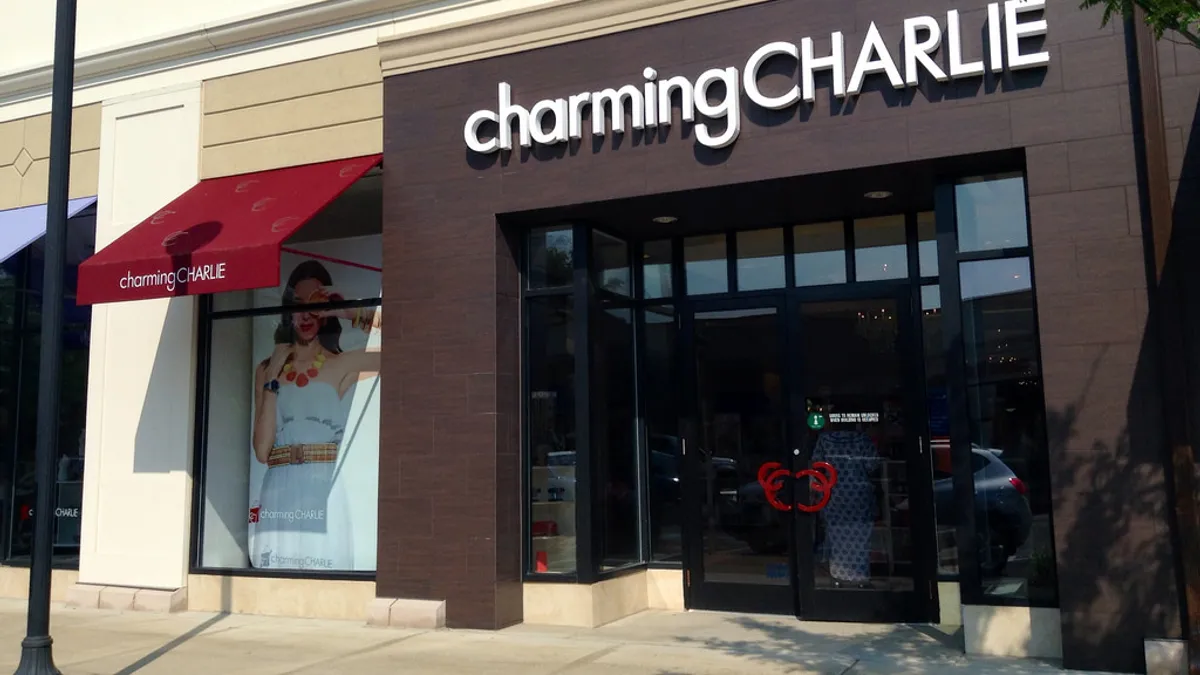Dive Brief:
- Apparel and accessories retailer Charming Charlie and its subsidiaries on Monday filed for Chapter 11 bankruptcy with plans to restructure its business and debt.
- The retailer went into bankruptcy with an agreement with the majority of its term loan lenders, which included a bankruptcy loan of $20 million, according to a press release. Charming Charlie also said in the release that it has entered into a $35 million asset-backed, debtor-in-possession loan with its current lenders.
- The company plans to shutter 100 of its 370-plus stores by the end of the year, according to a court filing from the company's chief financial officer. Last week Charming Charlie announced a plan to close an unspecified number of stores and to cut some corporate staff.
Dive Insight:
Charming Charlie's story is becoming a familiar one this year. A specialty apparel seller runs up against shifting consumer habits, which are compounded by its own operational and financial woes, and heads into bankruptcy court with a plan to shrink its footprint and balance sheet.
Charming Charlie CFO Robert Adamek said in a court filing that "the general shift from brick-and-mortar retail has been further exacerbated by merchandising miscalculations, lack of inventory [and] an overly broad vendor base, all of which has led to underperformance and reduced sales." Over the last several years, Charming Charlie's revenues have fallen 22% and its profits have dropped off by more than 75%, Adamek added.
While the company tries to adapt to larger shifts in the retail landscape, in the short run the retailer simply found itself "out of cash to responsibly operate its business," Adamek said. At the time of filing, the company had less than $1 million in cash balances and less than $1.8 million available under its revolving credit facility. That followed a fall where the retailer operated without enough liquidity. Adamek said that cash-on-delivery demands from its vendors "have paralyzed the stream inventory."
The retailer searched for additional, incremental liquidity, with reports breaking in October that Charming Charlie was in search of a loan to help it through the holiday season. But Adamek said those efforts failed, and the company was "unable to secure appropriate inventory for the November and December holiday season," creating the need for a Chapter 11 filing. In a statement Wednesday, Interim CEO Lana Krauter said, "We are confident that by reducing the size and scale of our business, we can focus on the core strengths that make the company successful."
Founded in 2004, the retailer made a name for itself by organizing accessories and jewelry assortments by color and pricing its products in a "sweet spot" between more upscale retailers like Macy's and specialty sellers like Claire's that cater to younger shoppers.
It grew into a retailer with more than $400 million in sales and a space on several lists of hot companies, according to Adamek. Backed by private equity firms TSG Consumer Partners and Hancock Park Associates, the company has struggled of late to pay off its debt after a period of rapid expansion.
Last year, the retailer reportedly explored a debt restructuring after it "failed to establish sufficient scale to compete in a highly fragmented market that has been tested by the rise of internet shopping and rapidly changing consumer tastes," according to Reuters.
Analysts with Debtwire wrote earlier this year that the retailer "has struggled in recent years with exposure to the highly fragmented market of fashion jewelry and accessories" but that "[t]his didn't stop Charming Charlie from expanding by 79 stores between 2013 and 2015." All of these struggles led Fitch and other analyst teams to put the retailer on their default watch lists.
Now Charming Charlie has joined the ranks of specialty retailers that have filed Chapter 11 this year in a last-ditch effort to restructure their business and match their finances and store fleet to a customer base that has shrunk. Those names include Payless, Gymboree, rue21 and True Religion, all of which entered Chapter 11 in 2017 and exited during the year, having executed in court plans largely prepared before filing.
The question hanging over all of them is whether their restructured businesses are truly right-sized, and if after bankruptcy they can hold onto the market share they have left.
This story has been updated.














